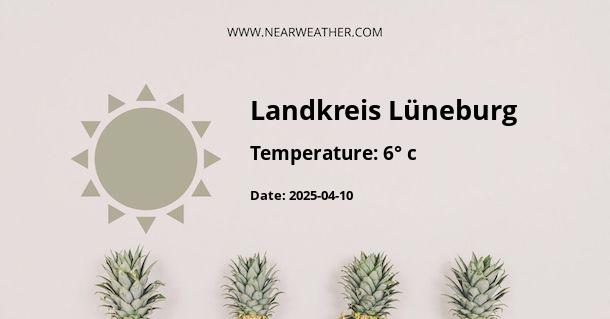The Climate and Weather of Landkreis Lüneburg, Germany
The Landkreis Lüneburg, located in Lower Saxony, Germany, is a region renowned for its picturesque landscapes, rich history, and distinctive climate. Understanding the intricacies of the weather patterns in this area is essential for those living in or planning to visit the region.
Geographical Influence on Climate
Before delving into the specific climate details, it's important to consider the geographical factors that influence weather in Landkreis Lüneburg. Situated in the northern part of Germany, the region experiences a temperate oceanic climate, which is characterized by mild summers and moderately cold winters. This climatic condition is largely shaped by the region's proximity to the North Sea and the prevailing westerly winds that bring moisture from the ocean.
Seasonal Weather Patterns
Spring
In spring, Lüneburg transitions from the cold winter months to a more temperate season. The average temperature during this time slowly increases from about 4°C in March to 14°C in May. Precipitation levels in spring are relatively low, with average monthly rainfall ranging from 40 to 50 mm.
Summer
Summer in Landkreis Lüneburg is generally mild and enjoyable. Average temperatures in the summer months hover between 16°C and 22°C. Rainfall during summer can be sporadic, and the region receives the highest amount of precipitation in the year during this season, with averages that can exceed 70 mm per month in June and July.
Autumn
Autumn sees a gradual drop in temperatures as the region prepares for the winter season. Average temperatures decrease from 15°C in September to about 6°C in November. Autumn is also characterized by increased rainfall, with monthly averages between 50 and 60 mm.
Winter
The winter months in Landkreis Lüneburg can be cold, with average temperatures typically ranging from 0°C to 3°C. Snow is possible but not very common, and rainfall decreases compared to autumn, averaging around 40 mm per month.
Detailed Seasonal Statistics
Temperature and Precipitation Overview:
- Spring: Avg. Temperature: 4°C - 14°C | Avg. Precipitation: 40 - 50 mm
- Summer: Avg. Temperature: 16°C - 22°C | Avg. Precipitation: 60 - 80 mm
- Autumn: Avg. Temperature: 6°C - 15°C | Avg. Precipitation: 50 - 60 mm
- Winter: Avg. Temperature: 0°C - 3°C | Avg. Precipitation: 35 - 45 mm
Annual Weather Trends
Tabulating the annual weather trends provides a clear picture of what to expect in Landkreis Lüneburg throughout the year. Here is a table outlining the average high and low temperatures, along with precipitation levels.
| Month | Average High (°C) | Average Low (°C) | Average Precipitation (mm) |
|---|---|---|---|
| January | 3 | -1 | 45 |
| February | 4 | -1 | 35 |
| March | 8 | 1 | 40 |
| April | 13 | 3 | 40 |
| May | 18 | 7 | 50 |
| June | 21 | 10 | 70 |
| July | 22 | 12 | 80 |
| August | 22 | 12 | 60 |
| September | 18 | 9 | 50 |
| October | 13 | 6 | 55 |
| November | 7 | 2 | 45 |
| December | 4 | 0 | 50 |
Extreme Weather and Climate Events
While Landkreis Lüneburg's climate is relatively moderate, the region is not immune to extreme weather events. Climate change and variability can lead to unexpected weather occurrences, such as heatwaves, severe storms, and flooding. The region is known to have experienced intense rainfall leading to flood events in the past.
Implications for Agriculture and Tourism
The climate in Landkreis Lüneburg plays a vital role in its agricultural productivity and appeal to tourists. A relatively mild climate allows for the cultivation of a variety of crops and supports outdoor tourist activities, particularly in the spring and summer months. However, farmers and the tourism industry alike need to be mindful of the potential for extreme weather events and adapt accordingly.
Climate Change Considerations
Like many parts of the world, Landkreis Lüneburg is not insulated from the effects of global climate change. Patterns of precipitation and extreme weather events may become more unpredictable, and temperatures could see gradual increases. This underscores the importance of sustainable practices and preparedness to mitigate the impacts of a changing climate on the local ecosystem and economy.
Conclusion
Landkreis Lüneburg boasts a climate that is typically Western European, with its own nuances that contribute to the distinct seasons experienced in the region. By understanding these patterns and preparing for variability, residents and visitors can appreciate the beauty and diversity of the weather in this part of Germany.
Key Takeaways
- Landkreis Lüneburg experiences a temperate oceanic climate, with mild summers and moderately cold winters.
- Seasonal weather patterns are distinct, with the highest levels of precipitation occurring in the summer months.
- The region's geography, including proximity to the North Sea, plays a critical role in shaping its climate.
- Annual weather trends reveal a range of average temperatures from 0°C to 22°C and precipitation levels that vary throughout the year.
- It is important for the local agriculture and tourism industries to consider climate variability and change in their planning.
A - Landkreis Lüneburg's Latitude is 53.293892 & Longitude is 10.566110.
A - Weather in Landkreis Lüneburg is 11° today.
A - Climate Conditions in Landkreis Lüneburg shows broken clouds today.
A - Humidity in Landkreis Lüneburg is 87% today.
A - Wind speed in Landkreis Lüneburg is 4.07 km/h, flowing at 34° wind direction. today.
